Also - See photos and comments from other
CES & ICCE,
CinemaCon(Showest
),
CTIA,
SCTE |
|
|
| Get on our distribution list - click here |
Photos,
Videos & Comments on the 2015 Internatinal Consumer Electronics
Show (CES)
& International Conference on Consumer
Electronics (ICCE)
|
CES Pre-Show & Press Events
Click on Photos to See Better Picture or
Video |
|
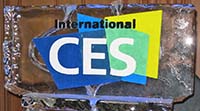
Welcome to DIGDIA's CES 2015
Photos, Videos & Comments!
|
While most people will visit CES on
January
6,
the main Press Events start on Sunday,
January 4. |
.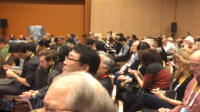
Click for Video |
 |
The Linx IAS (Impact Assessent System) borrows
technology developed for combat soldiers that are
exposed to blasts, only now it is aimed at athletes that
risk concussions. The sensor $199 sensor is worn
on the head and can send warnings to a phone. End of Q1 |
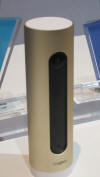 |
Face recognition will soon be available to watch over your home. The
Netatmo sits in your home and observes anyone that walks by it. You
can have it tell you when your kids have come home from school, or warn you
if it sees a face that it does not recognize. You get these alerts
sent to your phone. No price yet. Intro in Q2 |
|
The Ozobot is a clever $50 robot that kids can program
on their tablet. They can learn simple and complex
programming concepts and see if their progam works.
It is very interactive and makes learning programming
fun. You can buy it now. |
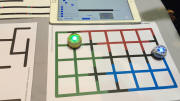
Click for Video |
eGeeTouch is applying Near Field Communications (NFC) to locks. Shown here
is a padlock that you open by touching to it an NFC token or an NFC enabled
phone. A TSA approved version will soon be available for your
suitcase, too. The padlock is about $70. |
 |
 |
Axxess CE (www.axxessce.com) has the AIR2 Bluetooth speakers, and they
are definitely going to be a conversation piece. If you look at the
photo closely, you will see that the speaker is floating in mid-air.
$199 |

Click for Video |
Logbar (logbar.jp) makes the "Ring". You use it to control Apps, etc. by
pressing a button on the Ring while gesturing with your ring finger. The
demo video is a bit short because of the many interfering Bluetooth
devices in the room. $269 for the metal version. A lower
priced plastic version is in the works. |
|
Visijax says their jacket is the safest jacket to wear while bicycling,
day or night. It detects when you are signaling for a turn and
flashes "turn signals" on your arm. Lights on the back flash red.
$160. |
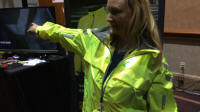
Click for Video |
The TempTraq by Blue Spark uses a sensor patch that you stick onto your
baby if it is sick. It takes the baby monitor to a new level. You
read your baby's temperature on your phone. Not yet available since
it is awaiting FDA approval, which may happen any month now. |
 |
 |
Vigilant makes a pair of products aimed at people with diabetes. One
makes it easy to monitor and record your blood sugar. It is called the
Bee smart tracker ($69, foreground). The other helps with in medicines
(background). |
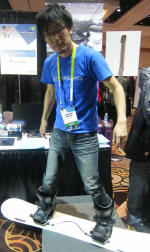
Click for Video |
Cerevo explains that once you get beyond beginner level in snowboarding,
you need help to get even better. Their special snowboard will give
you such help by providing feedback on your skills that you can then
analyze on your tablet. They expect to have this out by the end of
the year for about $500. |
|
Tao Wellness aims to get all you couch potatos fit and healthy with their
Tao Chair. While you watch your favorite TV show, you use the chair
to exercise and get feedback on your exercise. Look for this chair
at the end of the year. |

Click for Video |
Some people listen to music or the radio to help them get to sleep.
Trouble is, the spouse might not want to be disturbed. So, now you can
wear the Sleep Phones ($99) and listen to music or radio sent via
Bluetooth. An induction charger will be coming out in April to charge the
battery. |
 |
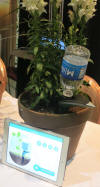 |
Parrot will soon make it easier to keep your potted plants happy.
The H2O has sensors that measure moisture, sunlight, etc. and waters the
plant as needed. Shown here is a version you use in any flower pot, but
they also have a version that integrates the sensors into the pot itself.
Coming out later this year. |
 |
Tired of transfering photos, music, documents, etc. between all your
devices? Now you can simply install the Lima App in all these
devices and share your content automatically. Lima works by using
the device shown here that you attach to your router. You also
attach a USB disk drive to the Lima. All your content is automatically
slurped up and shared amongst your devices. $149. |
(Day 2 Press Events)
LG starts the day with an 8AM Press
Conference and leads with their OLED TVs. While others have given up on
OLED, LG is going all in.
LG is also beefing up WebOS, which they
bought from HP, with ver. 2.0 |
 |
LG, like others, are also expecting 4K to become standard for anything
above 40 inches. They expect 60% of their large screen TVs will be 4K.
They, and others, are lining up 4K content from Netflix, Amazon, YouTube,
etc.
4K UHD is more than just pixels. Most
importantly, it is about High Dynamic Range (HDR). LG calls it
ColorPrime. Netflix's recent release of Marco Polo is in 4K resolution
and HDR. |

 |
What do you use that drawer under the front load washer for? We
store dog food there.
LG thinks it is a great place to put Mini
washer that you can use for small loads. Kind of like the double
oven idea. Saves time, water and energy. |
 |
The so-called Internet of Things (IoT) is a major theme this year, and LG
is now involved in two related "standards". AllSeen (aka Alljoyn)
is a protocol that lets devices understand each other (to a degree).
OneM2M is another protocol aiming to unify the communications between
devices. |
|
Sharp's claim to fame is the LCD display that they pioneered. Sticking to
their strength, they introduced 3 new lines: UB30, UE30 & UH30, all with
4K. The 43" UB30 is about $750 - priced to try to compete with China. The
largest screen is 80" (though 120" HD is also made by Sharp).
Of note, They are integrating Google's AndoidTV into these sets. They are
also continuing the use of their 4-color approach (Quattron). |
 |
Previously, Sharp introduced IGZO technology, which uses a faster
transistor for better displays. This year they teamed with
Qualcomm's "Pixtronix", which is a MEMS technology that mechanically
shutters RGB backlighting. The result is a more efficient display that is
viewable in daylight. It will show up in smaller displays that can
take advantage of the improvements. |
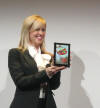 |
 |
Proving that OLED doesn't have the corner on thin displays, Sharp showed
off one of their LCD displays that will be less than 1/2 inch in depth. |
 |
Who said LCD displays need to rectangular? Sharp has a way to move
some of the electronics away from the bezel and make LCD displays of any
shape. Such displays can be useful in instrument panels, slot
machines, and other things where formfactor and design are important. |
|
Panaonic used to be known for to most consumers as a TV manufacturer,
plus some other CE products, such as cameras and Bluray. The last few
years the company has been emphasizing many of their other businesss,
many of which are market leaders. Many of these businesses touch
the consumer, but the Panasinic brand is not as visible. Last year
and this year Panasonic tried to get this message across. View the
video to get a better idea of what Panasonic is about these days. |

Click for Video |
Moving from HD to 4K UHD may sound simple, but is actually complex
because it involves several technical parameters, protocols and
standards. It is an old joke that the CE industry is based on
standards - just pick the standard you want to work with amongst several
that do the same thing. So the UHD Alliance is an attempt to
address 4K UHD from content, to distribution, to display. It involves
many key players from the food chain. We hope they get it right. |
 |
 |
Here is a slide that Panasonic showed that might help you to see the way
they now organize their "Consumer Electronics" divisions. Keep in mind
that there are many other parts of the company that re not in this
division, such as inflight entertainment. |
 |
When Panasonic dropped Plasma TVs, they had to prove that their LCD
displays were "just as good" - a tall order given Plasma's advantage in
better blacks. Panasonic is now saying they can achieve 98% of DCI
(a digital cinema spec for movies) and truer LUTs (a mathematical way to
translate colors). |
Samsung currently leads the pack in consumer electronics. Here is
an overview video of what they are about these days. Note: Samsung
is also giving the keynote tonight, and some of the big announcements are
being held back for the keynote (which might explain the somewhat subdued
press event).
Update: apparently, not much was said during the
keynote. Big emphasis on IoT was the theme. |
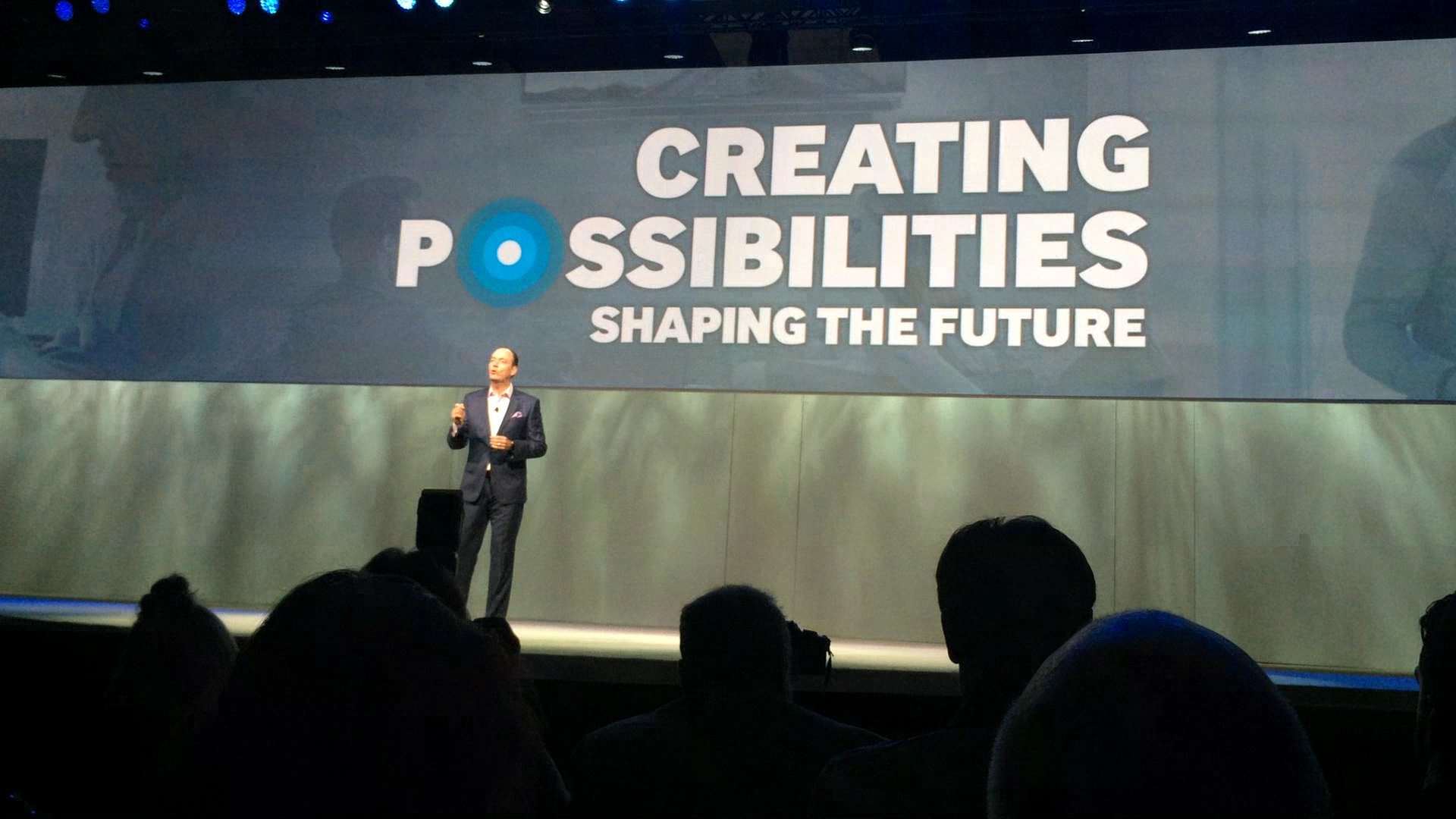
Click for Video |
SD, HD, UHD, and now "SUHD"? In an attempt by Samsung to say their
LCD TVs are better than OLED, they are now pushing the idea of "SUHD" (I
wonder if anyone there tried to pronounce this acronym). In this case,
Samsung is using their own Quantum Dot technology (other TV mfrs. get
them from 3rd parties). Marketers like
to point out the "Techron Inside" branding trick; but in this case it may
just lead to more consumer confustion. |
 |
 |
Samsung wanted to show off some of their product and industrial design
innovations. A couple of things to note. One is that the aspect
ratio seems wider than the standard 16:9 format (though they didn't
mention this fact). Two, is the "box" that the TV sits on.
This box is integrated with the TV and hold such things as speakers.
Personally, I'd be a little nervous about what appears to be a top heavy
design. |
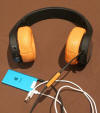 |
Now we switch back to some smaller companies.
Phaz has a powered
headset they call the P2 ($249). It accepts analog audio input. It
is amplified with bass boost. But, it also has a USB port for powering
your phone or music player (1200 mAh). An issue is that a second cable is
needed for powering your device. In a year they will have the P5 which
accepts digital audio in, so only one cable is needed. |
|
ODG has been selling a $5K version of these head-up glasses to the
military. It has sensors to work with virtual reality systems.
The photo shows a consumer version that they will sell for under $1K -
the R-6S.It differs from some similar glasses in that you can still see
what is in front of you. They also sell a control that you wear on your
finger. |
 |
Zano is preparing a miniature autonomous drone. A simple think that it
can do is hover above you wheree\ver you go. They have APIs for
developers that want to create special Apps of their own. This can
get spooky. Expect first models in June for about $269 |
 |
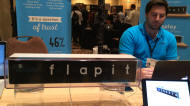
Click for Video |
You've probably seen this type of mechanical display in airports or train
stations in the past (if not today). The flipping characters gets
your attention as you try to guess what it is going to spell out.
Now you can have your very own Flapit Display for $299, starting in
April. You program it via a web App, but it connects via your WiFi
network. |
 |
Here is a new angle in social networking. Place the BloomSky on your
window sill and it takes a photo of the sky every 5 minutes. The photo
and other weather parameters (temperature, humidity, barometric pressure)
are uploaded to the cloud. Now you can get an idea what the weather is on
a map you see on the web. $149 in April. |
|
The Budgee, by Five Elements Robotics (5erobotics.com), is a little cart
that follows you around. People have thought of applications in
stores, libraries, airports and for the handicapped. Sensors help it from
bumping into people or objects. It will be out in March for about
$1.4k |
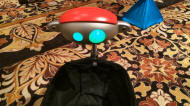
Click for Video |
Wonder Workshop has a learning toy called DASH. You can program it using
Google's Blockly or a much simpler method called "Path". The
smaller version of DASH is called DOT. You can get a set of both for $259 |
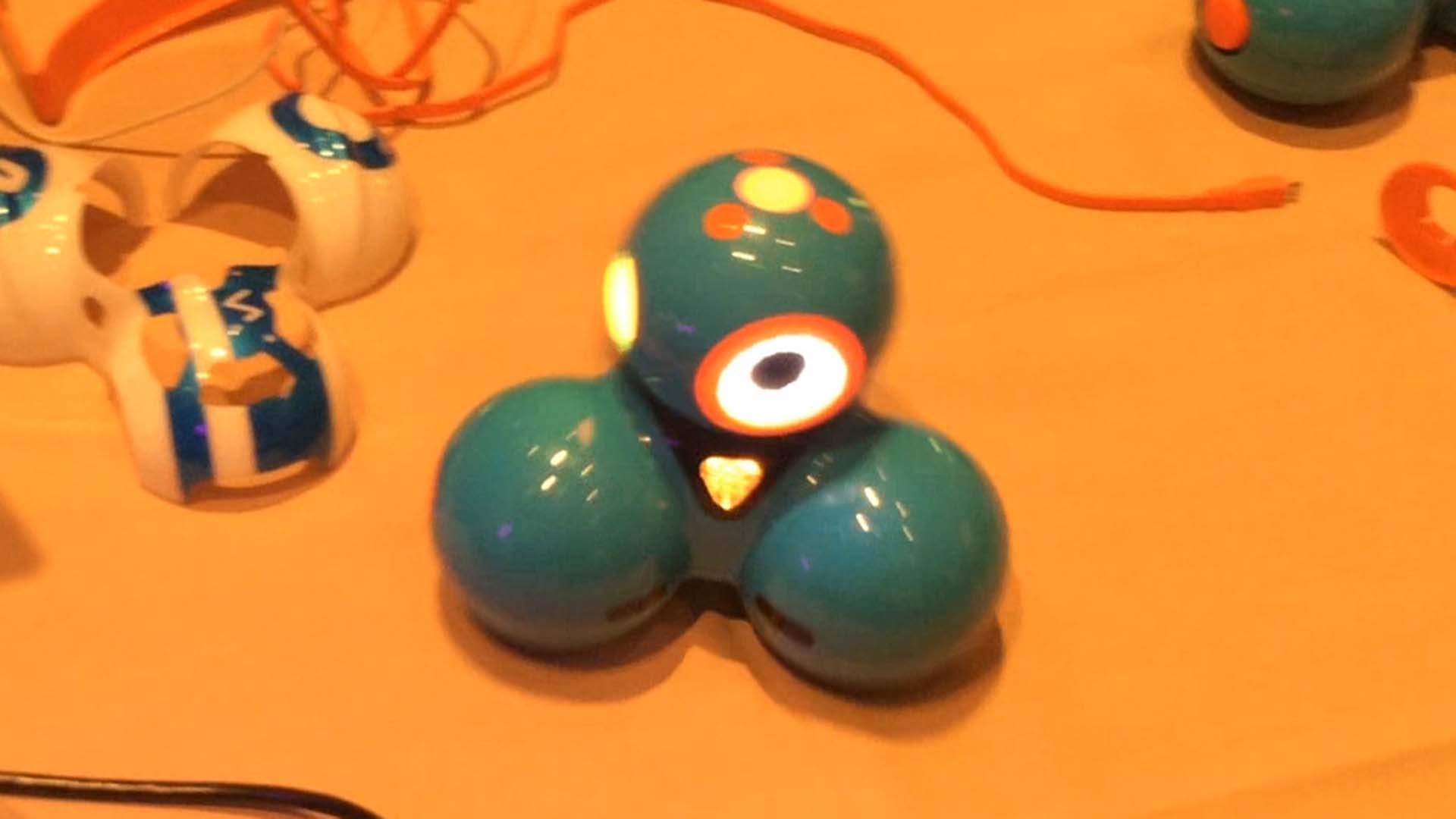
Click for Video |

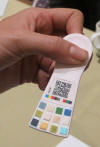 |
Scanadu has a pair of interesting home health products. The Scout (top)
measures blood pressure without needing cuff. Simply press it
against your forehead. It also measure blood oxygen levels. They
are seeking FDA approval. It may sell for $299.
The ScanaFlo
(bottom) is a disposable urine tester. You can test for such things
as diabetes, kidney or liver disease, UTI and more. It is also
seeking FDA approval. |
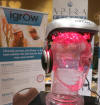
 |
Apira Science has a pair of products that may make your hair stand on
end.
The iGrow (top) is worn by people that have hair loss. It
shines 655nm laser light on your head, resulting in a 35% increase in
hair growth. $695
The iDerma (bottom) is worn over your face and
it helps to reduce lines and wrinkles in your face. $399.
Find out more at igrowlaser.com |
|
This is an Oku (getoku.com). You hold the sensor against your skin and it
shows advice on your iPhone about how to take better care of your skin.
You get a SkinScore and can track the health of your skin. $249 |
 |
The Gogoro is a battery operated scooter. It has a range of about
50 or 60 miles and a top speed of 60 MPH. You swap out a pair of
batteries (those green modules) at kiosk stations spaced every few miles
in urban areas. No price or availability yet, but it should be out
this year. |

 |

Click for Video |
When our kids were babies we found that driving them around in the car
put them to sleep. Now you don't have to use the car - just put the baby
in the Mama Roo by 4MOMS. $239.
Also in the video is a
stroller they call Origami. It will be quite obvious in the video
why they gave it this name. $849. |
CES - Day 1
Click
Photo to enlarge or see Video |
|

Click for Video |
Ever wonder how you'd look with different eyebrows or makeup? Mirror on the
wall, the Panasonic Magic Mirror shows you all...Click the video to get a
full appreciation of this product, which not a gimmick, but a real thing. |
 |
Panasonic showed a working prototype of a 4K Bluray player. This player can
use a 2 or 3 layer disc which hold 50 GB to 100 GB (a 66 GB disc also
exists). Video is encoded in HEVC. Bluray is expected to finalize the
standards for 4K this summer, which will go a long way towards true 4K home
viewing. |
|
DSLRs are increasingly used for cinema production. This
gives you an idea of how Panasonics GH4 DSLR camera body
can start at $1.7K and get loaded up with all the
rigging and lens into a $37K envy camera. Unlike its
professional cousins, it uses SD cards for media. |
 |
For most consumers, however, a lower cost $1K Panasonic W970K
camcorder might do the trick. This camcorder has a 2nd lense that captures
a 2nd video stream simultaneously while you record through the main lens.
Good for selfies so people can see your face when you video Brad Pitt. Or,
maybe the reaction from parents as your kid kicks in the winning goal. |
 |
 |
Panasonic sells this electric assist bike in Japan. It uses
Panasonics Li-Ion batteries, much like the ones used in the Tesla car.
A charge can last 25 to 50 miles, depending upon the terrain. This
bike costs $1050, but a tricked out version with all the high-end bike gear
goes for $5K. |
 |
Wi-Fi and Internet connectivity is increasingly found on airplanes.
In order to get to the world wide web, you need an antenna that
communicates with the satellites. Turns out Panasonic makes these,
too. |
|
About four years ago Panasonic took the Technics brand
off the shelves. Technics is now back with the R1
Reference Audio series. Shown here (left) is the
SU-R1 Network Audio Control Player, and (right) the
SE-R1 Stereo Power Amplifier. Both sport the "serious
audiofile" look. |
 |
Sony's booth was reminiscent of a their booth over a decade ago, with a
dramatic 360 image to suggest you are now in Sony's world. The
products they showed were mostly traditional audio-video and mobile
electronics. |
 |

Click for Video |
Sony is showing their Eyeglass Attach prototype. It can attached to
prescription glasses, your favorite shades, or perhaps your goggles.
It has a camera, heads-up display and electronic compass. It is not
yet available and no price was given. |
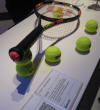 |
In the Eyeglass Attach video you may have spotted the tennis player example
and wondered how it was done. Sony's Smart Tennis Sensor is the key. This 8
gram sensor clips to the butt of any tennis racket and collects enough
information to know how well you are playing the game. Ball speed and
spin are just a couple of things it can figure out. Very slick.
Expect this early 2015 for about $200. |
|
LED-based pocket projectors are starting to get
practical. This is Sony's MP-CL1 projector and it folds
up nice and flat so it slips into your notebook bag. It
has a 1920 x 720 image that is bright enough for a 120
inch diagonal image. A screen 4 feet away gets a
40" diagonal image. No price or availability yet. |
 |
Now that 4K is getting to be expected in many homes, Sony is finally able
to show their 4K cinema projectors at CES to help position the company as a
4K leader. Sony has been showing their 4K SXRD theater projectors at
Cinemacon (formerly Showest) for years. It is shown here for folks
that might be curious what one of these projectors looks like. Note:
the port at the top is for exhaust because these Xenon bulb projectors get
very hot. |
 |
 |
This LG 34UM67 monitor is aimed at gamers. It has a 21:9 2560 x 1080
resolution display and measures 34 inches diagonal. Now the bad guy
won't disappear in the crack between two displays. |
 |
This LG 34UC87M monitor is aimed at brokers. It has a higher 3440 x
1440 resolution in the 21:9 aspect ration. It, too, is 34 inches
diagonal. It costs $1300, but a less expensive model exists at $1199. |
|
In the past few years 8K displays were shown just to say
that it can be done, but there was never a hint that
real products would come out soon. Now that 4K
displays are on relatively firm footing, almost all
major companies are showing 8K product prototypes.
The one shown here is from LG and it is 98 inches. |
 |
If there was a major theme amongst this year's TVs, it was Quantum Dots.
This is a technology that creates precise RGB colors for the backlights in
LCD displays. Such control means better color. Almost all major
companies had a high-end product that uses this technology, even though
many were prone to give them funny names in an attempt to position their
display as better. |
 |
 |
These hanging objects are speakers from Samsung. They eminate the
sound in 360 degrees. These speakers might be useful in certain
commercial applictions, or for the homeowner that just wants to make a
statement. |
 |
Like last year, all of the Chinese companies had what looked like clones of
all of the Korean and Japanese CE companies. So, we will just
highlight a few things that might be a little bit unique.
Here we
show a laser projector from Changhong. The projector sits on the
table and throws a 100 inch diameter image. |
|
Hisense actually didn't have anything original, but they
were particularly unabashed at demonstrating their 'wide
color gamut'. The difference was so dramatic
compared to other company demonstrations that it leads
one to wonder if they tweeked the color settings a bit. |
 |
Haier showed that they are interested in curved OLED, too.
Skyworth
showed that they are interested in curved OLED, too. |

 |
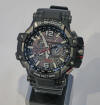 |
There were so many so-called wearable electronic products at the show, we
chose to ignore them. Quite frankly, nothing really caught our eye as
something worthwhile. They seem to suffer from stuffing 10 pounds of stuff
into a 1 pound watch.
So, instead, we show the Casio GShock watch
that does just one thing - tell time. It uses the GPS signal to do so
precisely and based on exactly where you are in the world. $950. |
 |
This is a cute 360 degree camera. It uses two fisheye lenses on
either side. It stitches the two images together and you can view the
resulting image much like you can with other 360 degree cameras. The
nice thing about this camera is that it is flat, so you can slip it into a
pocket. $299. |
|
You've probably seen TV commercials where everything
stops frozen in midair while the camera angle moves
around the scene. If you wondered how it is done,
this setup from Nikon shows you how. |
 |
With the dawn of LED lighting, all kinds of "smart" light bulbs have been
coming out. This one from Stack Lighting senses the room's ambient light
levels and the presence of people in the room. If conditions are right, the
light turns on to an appropriate level. But, it also talks to other
lights in the room via Zigbee to turn them on as needed. The photo
shows the BR30, which puts out 750 Lumens for 13W. It comes out this
Spring for $60. |
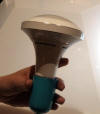 |
 |
Now you can hot foot it to your next appointment even if it cold outside.
Glagla makes the Digitsole that slips into your shoe. A built-in battery
can heat up your feet based on the settings you picked in your iPhone App.
The battery lasts 6 to 9 hours. The Digitsole also tells you how many steps
you took today. $200 |
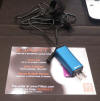 |
We saw this last year when this company, finSIX was barely off square one
and didn't have a working prototype. They are back this year with
working models and have started UL approval. It is an AC adapter for
your notebook/tablet/USB powered device. It supplies 65W. Yet, it is very
small. The secret is an incredibly high switching power supply
frequency (for those that can appreciate it, it is "many" MHz) The product
is now called the DART. They are taking orders now for $89. |
3Doodler showed up last year. This year they've
made some significant improvements. See the video
to learn more.
The photo on the bottom shows a
dress that was made with the new pen and materials.
It is flexible, so it might actually be wearable. |

Click for Video
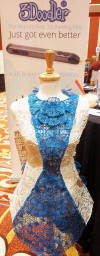 |
Blisslights has an interesting niche market - creating magical lighting for
parties, events and special occasions. The video shows Pixxy (Q4,
$300), which must be viewed to appreciate.
The photo (bottom) show a
pair of Sprights (which came out earlier, $200) that make the sea of lit
dots.
The ball is SKY which comes out in Q2 ($200). It produces a
sky-like mood on the ceiling. |

Click for Video
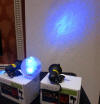 |

Click for Video |
The past few years has seen some unique personal transportation devices.
Some looked a little more iffy than others. This one from Hovertrax
hopes to have addressed many of the usual issues. They have a video
that shows people riding it in the office and another person moving boxes
in a wherehouse.
The video (which has bad audio) first shows
an experienced rider. The interesting part to watch is of someone that is
trying it for the very first time. Will it end in disaster or will
this person pick it up fairly easily?
A few details. Top speed is 5
MPH. Range is 8 miles. Weight is 15 pounds. Price is $995. |
|
|
|
|
CES - Day 2
Click
Photo to enlarge or see Video |
|
|

Click for Video |
Consumer drones are getting to be pretty common at CES, so it is hard to
get our attention with drones. Parrot succeeded with their
choreographed dancing drones, starting their Bebop. Like most such
drones, it can be controlled via an App and has an HD camera. $499 |

 |
Last year a very small booth by another company had a table and laptop and
their Bitcoins. This year a company called Circle showed up with a
major booth - and they were giving away Bitcoins! All you had to do
was install their Circle Bitcoin App. The bottom photo shows Circle's phone
sending $5 and my phone (taken later) with the resulting funds. I
took the photo of my phone 10 minutes later and the funds had shrunk to
$4.99. An hour later, as this is being posted, it is worth $5.15. |
|
Dino-Lite (dinolite.us, formerly BigC) has a series of
digital microscopes that range from $100 to $1K.
Their newest one uses Wi-Fi instead of cables. Another
new one has a depth of field of about 1/2 inch.
The one shown, AM4113ZT has a 10 to 220X magnification
and goes for $500. |
 |
We showed a still photo of this last year. It looks better in the video.
It is the VirtuixOmni TRAVR Shadow Ops rig (virtuix.com). It helps to
wear the special slippery shoes. If you buy this by Feb 1, 2015, it
is $499. After that it is $699. |

Click for Video |
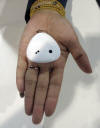
 |
A couple of companies, Smartech and Lovepac, have worked together to create
a unique piece of jewelry for women. When the phone rings, instead of
desparately digging through the purse, you just need to hold your hand in
front of the pendant and the caller's ID is projected onto your hand. If
you want to answer the call, you take out a small earbud in the back of the
pendant and talk. It comes in white or black. $399 |
 |
A company called Pure Imagination is selling the Perfect Bake
(perfectbakeapp.com)
The key is
in the App because it allows for the measurement (via the electronic scale)
of ingredients with 1/4 gram accuracy. You call up recipes and the
App tells you what to do. Here it told the cook to use the green bowl (you
can use your own bowls) and pour chocolate chips in it. The App tells you
in realtime how much you are pouring and when to stop. Later this
year this will use Bluetooth, and sell for about $70
|
|
Carson makes several types of scopes. Here they
have an adjustable clip that attaches your phone to
these scopes so that you can view and record the images
seen in the eyepiece. It is a little delicate, but a
relatively inexpensive alternative to the more
integrated professional solutions. The Universal
clip sells for $65. |
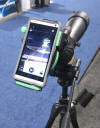
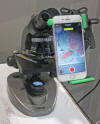 |
Eton makes a number of products that come in handy when you lose power.
Here we have the BlackoutBuddy H2O light. It uses no classic
batteries. Instead, you just drop it into water to activate it.
The light stays on continuously for 72 hours. It is a single-use
light, and once it is activated, it can't be turned off. A pack of 3
sells for $15. |
 |
 |
Here is one of those products that is simple, yet perhaps perfect for a
certain market. Can you figure out the market? It is the LH104 by
DSI. |
 |
Here is a cute little gift idea for someone that wants to add a little
sparkle to their life. It comes from Fashion Electronics. The $10
adapter provides 3.1 Amp of charging power. The cables are separate. |
|
NXTID just made credit card skimming easier with their
Wocket Wallet. The "Wallet" (top right) holds a
programmable credit card (top left). You plug the reader
(bottom) in and swipe a credit card through it. the
"Wallet" can hold many different cards. To call one up,
you press some buttons on the "Wallet" interface and
take the programmable credit card out and make a
payment. The company says that it will only hold
the cards of one person, but that just means a thief can
use a stolen card until they skim another one.
This Wocket Wallet has some other challenges. 1)
Merchants aren't going to accept a blank looking card,
2) it does not have a "chip", so it won't be any good
next year, 3) the "Wallet" is supposed to replace your
regular wallet, but it is bulkier than a regular wallet. |
 |
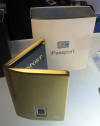 |
The iPassport from iWallet is supposed to make your passport more secure.
You lock your passport in the case and it can only be opened by your finger
scan. The case is made of tough carbon material (the one shown is a
prototype of a version not yet available). The rechargeable battery
is supposed to last 40 days.
This product may have a couple of
challenges. One is that fingerprint scanning isn't reliable if your
fingers are dirty. Another is that the battery might die inbetween
periods on non-use, so you would have to hope you have a way and the time
to charge it back up to open up the case. |
The novelty of packing fancy electronics into a car is
starting to fade. Everyone was talking about their
new and improved infotainment systems. OK, nice,
but the electronics industry's next real challenge is to
make sustainable transportation affordable.
Tesla, Panasonic and others are working on
battery-centric solutions. Toyota is also working on
fuel cell (hydrogen) based solutions. The first
real Fuel Cell commercial car will show up in the U.S.
market this Fall for $57K. The photo shows the
Mirai Fuel Cell Vehicle (FCV). It is a first step. It
has a 300 mile range, so the next industry challenge is
the refueling infrastructure. |
 |
 |
 |
 |
Another holy grail in automotive technology is the self-driving (or
at least assisted driving) car. NVIDIA used this challenge to
illustrate their new Tegra X1 processors, two of which can be seen on the
board on the left. Each of these processors can do a Tera FLOP, so
this board can do 2 Tera FLOPs - unimaginable in just about any form factor
just a decade ago.
The photo to the right shows a simulated
parking of a car in the NVIDIA parking lot. It assumes only 4 fisheye lens
cameras instead of the bulky camera arrangement that Google cars currently
use. The four camera views are shown on the right half. |
CES -
Day 3
Click Photo to
enlarge or see Video |
 |
When your in the wilderness or desert your phone is often
out of range of any cell towers. So, if you have to
communicate with your hiking buddies, you need to carry a
separate radio. GoTenna lets you use your regular
phone instead. Your phone talks to the GoTenna via
Bluetooth and then to your buddy's GoTenna via a 150MHz
radio link. 2 to 4 mile range in most outdoor settings,
but up to 6 miles in a flat desert. $150 |
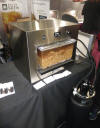 |
Zymatic makes a "Set It and Forget It" beer making
machine called the PicoBrew (picobrew.com). This is
a fully self-contained system, except for the external
keg that you see in the lower right of the photo.
After you add the ingredients, it controls the brewing
process over the next 2 weeks. Stronger brews above
12% might need an intermediate step. A social map lets
you see who is brewing what across the world and share
recipes. $1799 (without keg) |
|
Prescient Audio makes a unique subwoofer driver
(speaker) called the ThinDriver. Its optimal input
is 250 to 450 Watts. It is aimed at 20 to 200Hz. It
weighs only 8.2 pounds and is thin enough to hide
between the studs in the wall. Its thin light design
affords some unique design freedom for speaker
manufacturers. |
 |
BonaVerde translates to Green Bean. The idea is to buy
green beans directly from the farmer - a sort of Fair
Trade act. You go to their website and order raw coffee
beans from the farmer of your choice and they arrive a
few days later. Put a small cup of these beans in the
BonaVerda roaster/brewer and 15 minutes later you are
sipping somr fresh roasted and brewed coffee. Special
filters prevent roasting smoke and oils from spoiling the
experience. Available this Summer for $500. |
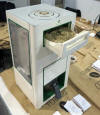 |
 |
If your baby is sick and you need to monitor the baby's
temperature, don't resort to the usual thermometers - use
Blue Maestro's Pacif-i. The pacifier looks like most any
other, but it is constantly measures the baby's
temperature and sends results to your phone via
Bluetooth. The battery lasts 18 months, about as long as
a pacifier does. Available in February, $35. |
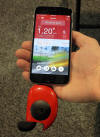 |
Most breathalizers just tell you if you are intoxicated
and you shouldn't drive. The Floome from 2045Tech
estimates when you will be able to drive based on your
body mass index. It plugs into the audio jack of
your smartphone and does not need any batteries. It
goes on sale in Italy in February for 59 Euro, and in the
U.S. in a few more months for about $75. |
|
iPhones have a built-in flash, but it is limited.
NovaPhotos makes a remote flash for your iPhone.
The flash can be up to 20 feet away. You can adjust the
flash's temperature and brightness by setting two sets
of LEDs - one for cool and one for warm whites
(see App). A charge lasts about 150 flashes. You must
use either the NovaPhoto camera app, or one from 645 or
Pureshot. $59 |
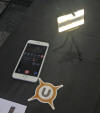 |
Haptics is about providing tactile feedback.
UltraHaptics is a company with a unique way to provide
such tactile feedback. As you wave your hand above
the array of emitters on the table, your hand will feel
the feedback. Feedback can be directed to different parts
of the hand in different patterns. The demo in the photo
lets you turn up or down the dial by rotating your hand
CW or CCW. They have evaluation kits for developers now
and hope to have products in a year or two. |
 |
 |
If you travel outside the U.S. you know that voice and
data roaming charges are expensive. So, maybe you
buy a local phone, but it won't have any of your handy
Apps on it. KnowRoaming might be your answer if you
have an unlocked phone. Simply put their SIM sticker over
your SIM card (the black/blud device is a rig to help you
do so) and put funds into your prepaid Know Roaming
account. For $7.99/day you get unlimited data in 55
countries, or you can pay 15 cents/MB in 200+ countries.
Voice is 10 cents/minute to land lines and 13 cents to
mobile phones. Works for iPhones, Android, Windows (and
soon Blackberry). |
 |
Another personal transportation gadget here.
Rollkers would like you to slip these one so you can make
it to your destination faster. They can go up to 7
MPH. While the batteries last perhaps an hour, a
regeneration system recharges the batteries when you take
normal steps. They are supposed to be stable enough
to wear as you go up or down steps. I hope someone has
good liability insurance. $500, sometime in 2016. |
|
GreenCreative would like to solve that problem of people
tossing the wrong type of recyclables into the wrong
bins. Simply put your empty container or
recyclable trash into the blue-lit hole and it
compresses it and puts it into the appropriate bin. If
your bottle still has too much in it, or you poke your
hand in there, the light goes red. The R3D3 uses
GPRS to communicate to the manager the status of the
bins. Starting in June these will be available for
$5K, or $3.6K in large quantities. |
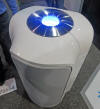

 |
What shape is your tummy in?
Emiota wants you to
not worry. Just wear their "Belty" and it will
automatically adjust to your tummy as you stand or sit.
Eat too much at that party? No worries - Belty
automatically expands. They hope to have this on
sale at the end of the year. |
 |
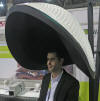 |
Is that Maxwell Smart in the photo? Remember
the "Cone of Silence"?
Silentium hopes to
deliver just that later in the year. On the
practical side, they want to make your wait less
stressful in busy airports and train stations, etc.
They call this the Comfort-Shell. |
 |
While growing up my mother was always telling me to not
slouch. UPright plans to sell you their UPright
sensor that you wear on the small of your back. If
your posture needs addressing, it will tell you.
Available in June for $129. |
|
|
|
|
|
CES - Day 4
Click Photo to enlarge or see Video |

Click for Video |
Yesterday we showed a set of powered boots that seemed a little bit too
high. This set here from Rocket Skates is lower to the ground and
perhaps more stable. They come in three range models, R6, R8 and R10,
priced at $500, $600, and $700 respectively (the number is the range in
miles). Top speed is 12 MPH. As with all of these alternative
transportation gadgets, viewing the video might help one to get an idea how
it works with real people (and people with practice). |

 |
This one is for the fisherman in the family that always checks the
fishfinder to see if it is a good spot to stop. Trouble is, these
fishfinders work on a boat, not from shore. Well, Deeper has solved
this problem with a fishfinder that you can cast out to a spot you think
has fish. Or, if you ice fish, you can pop one in the hole and check
out what is below. The fishfinder sends back its sonar readings via
bluetooth to your phone or tablet (within 130 feet). If you are night
fishing, the Deeper fishfinder lights up an LED lamp. $229 today. |
You wake up in the middle of the night and just as you
start to fall back asleep ...BEEP...you hear a smoke
detector announce a low battery. But, which one?
Or, maybe you actually have a fire in your home but you
are not there. No one is there to hear the smoke
detector alarm.
SmartRoost.net has an answer. These
five year batteries replace the batteries in your smoke
detectors. Each one can communicate over
Wi-Fi so
your phone can tell you what each smoke detector is
seeing. Comes out in June, and $120 buys four
Roost batteries. |
 |
3D Systems is one of the leaders in 3D printers. Here they are
showing the ChefJet Pro, which will be available at the end of 2015 for
about $20K. The cakes in the top photo all have a confection sugar
design that decorates the top or sides. The decorations are delecate,
but can be eaten. To do all the parts of the pink cake took about 10
hours to print. Different colors can be added to the sugar as it is being
printed, as was done for the wedding couple top. |

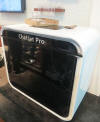 |
 |
PLH Products, under the Healthmate brand is showing their Half Sauna.
IR beams are blasted on the lower body to increase circulation and health.
This product is apparently popular in Korea and other parts of Asia.
It is now coming to the U.S. where it will sell for about $2200. |
 |
A company called Jins makes these special eye glass frames called the Meme.
Look closely near the nose bridge and you will see some sensors that Jins
say measure the corona of your eyes. Measurements like blink rate,
fatigue, number of steps taken, rapid eye movement and others are made and
displayed on your phone. Perhaps you are driving and you are getting
sleepy? The Meme can warn you. No price yet, but expect it in the
Fall. |
|
This person is wearing a Swarovski Vio pendant. Hidden
behind the Swarovski crystal is an accelerometer that
can track the usual parameters. So, now you can
look stylish and still keep fit. They have a
number of different jewelry options, so you can pop out
the sensor and insert it into the fashion style you
choose. $249, available in March
swarovski.com/smartjewelry |
 |
This person is wearing a TickrX from Wahoo Fitness. It is positioned at the
center of the body to more accurately measure heartrate, repetitive
counting, ground contact of feet, speed and distance. It is for the
serious fitness person. $100. |
 |
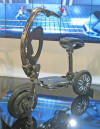
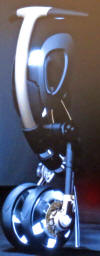 |
Here we have what may be the most stylish electric scooter around, and yet
it has some interesting features to make it practical, too. Greenride
calls this the INU. It has a 25 mile range and a top speed of 18 MPH (to
keep it within certain regulations). But, it can be folded up to the size
of a bag of golf clubs and legally checked in as baggage on airline
flights. It weighs 45 pounds. Arrive at your destination and you can ride
off to the hotel without needing a taxi. It also has a WiFi hotspot
and the ability to track where it is remotely. $6K ($4K for lower range
model) |

 |
SmartMat makes a yoga mat called the SmartMat. There are over 21,000
sensors built into this mat. The mat tells you if your yoga movements are
being done properly. You get feedback on your tablet. The
tablet app can also give you animated instructions on how to do various
yoga movements. The SmartMat will be available in July for $297. |
Some people are obsessed with whitening their teeth.
BleachBright has a $1900 system that will whiten your
teeth in just 20 minutes. The disposable mouth inserts
cost $100.
With that, we say goodbye to CES 2015.
Next up is ICCE. |
 |
|
ICCE (International Conference on Consumer
Electronics) |
If you are not familiar with ICCE, think of it as the
R&D counterpart to the Marketing done at CES.
Why
would you care? Because the R&D folks are inventing the
stuff that you will see in future CES events, only
they are talking about it now.
ICCE is run by the
IEEE Consumer Electronics Society
The following
is a small sample of some papers.
Click Photo to enlarge |
Back in the day, there used to be online services like
Compuserve and others that allowed messaging and sharing
of files. But, these various services were closed
systems that did not to each other.
Today we have the
Internet, so most with the exception of closed corporate
and government/country systems (and the dard net)
everyone can send messages and share files with just
about everyone.
But, we also have the emerging
"Cloud Computing" systems. These cloud networks,
it turns out, tend to be closed and so they do not talk
to each other. Stephen Diamond, chair of the IEEE
Cloud Computing Initiative, would like to help these
cloud systems communicate with each other using a
concept of an InterCloud API (Application Programming
Interface, basically a way to translate to a common set
of commands and messages). |
 |
 |
Jihoon Park (CISS, Korea) is thinking outside the box on
an experimental way to automate the recharging of
electric cars in your home. He proposes putting the
recharging plug on the underside of the car. This makes
it possible for a robot, somewhat like those vacuum
cleaners you've seen, to position itself under the
recharging connector automatically after you drive your
car into the garage or carport. He uses an array
of RFID sensors to zero in on the car's recharging port.
This approach is not yet talked about in the industry,
according to Park, but it does not need to be a standard
to work. An individual car mfr. could decide to do this
one their own.The photo shows his test system. |
|
The problem with high-end audio in the home is that one
usually has all kinds of furnature, curtains, and other
objects and surfaces that distort the sound. Also,
speaker placement is often not optimal. Markus
Christoph (Harman, Germany) talked about a way to first
calibrate and then compensate for such issues. The
approach involves mixing the sound intented for each
speaker using a complex algorithm such that, for
example, sound intended for the left front speaker is
partially sent through the other speakers in the room,
too (but just at the right amplitude and phase).
Various tradeoffs can ve made between accuracy,
complexity and sweet spot size. |
 |
 |
Prof. Byun-Gook Park, the President of IEIE (a Korean equivalent of IEEE)
talked about memory. In particular, he talked about Flash memory that
is so common in everything today. In 1995 a 20 MB flash card from Sandisk
cost $1000. In a few years, flash memory will start to catch up to
hard disk drives in cost effectiveness. But, that assumes that flash
memory can continue to shrink in memory cell size. This assumption,
it turns out, has some challenges as the number of electrons that are
stored in a flash memory cell is getting fewer and fewer, and thus less
reliable. So, what might be the answer? Changing the structure of flash
memory cells into a three dimensional one that increases electron storage
capacity without increasing physical size. This is a continuing area
of research as there are new sets of challenges that need to be addressed. |
|
Prof. Sean Olive, President of AES USA, has been
conducting tests of younger people to see what kind of
preferences they have in audio. It had been asserted by
some that younger people might actually perfer the lower
quality of MP3 and cheap headphones and speakers over
higher quality audio sources because that is what they
have grown up on. Sean's tests have consistently proven
that theory wrong. Young listeners prefer CD over
MP3 (he noted that some LP records have less dynamic
range compression and can be better than CD). Young
listeners also prefer higher accurate speakers (he noted
that price does not always match audio quality).
In headphones he noted simiar conclusions, though he
noticed that listeners like a litte bass boost and that
good physical fit can made a difference. |
 |
 |
Lucia Pepa, Italy, presented a project aimed at helping people with
advanced Parkinsons, when there is a problem called Freezing of Gait (FOG,
a difficulting in walking). Special equipment that detects FOG has
existed, but problems of usability and acceptability exist. Pepa and
her team decided to see if an ordinary smartphone could be used instead.
The phone is worn on their belt, much like some do for regular use.
The accelerometers in the smartphone are used to detect a FOG event and an
audio stimulus is given to help the person coordinate their walking
cadence. |
|
Unless one has a fancy wind noise filter for the
microphone, anytime there is a little wind while
videoing a scene can be a frustrating experience when
the results are viewed and listened to. Akihiko
Sugiyama, et al, from NEC are working on a wind noise
suppression algorithm that can run on an Android system
(i.e for phones and tablets). Traditional wind
noise suppression techniques are not practial here
because they require too much memory or computational
power. NEC's approach uses a static model for wind
noise, which is not ideal, but still effective. |
 |
 |
4K TVs were almost defacto at CES, and many 8K TVs were previewed. All
these pixels take up a lot of bandwidth, making it a challenge to broadcast
good video over the airwaves. Yet, NHK intends to do just that for 8K
video in 2016. To squeeze an 8K or 4K video signal into more
practical bandwidths, a compression of up to 1000 to 1 is needed. Such
compression usually results in lots of "artfacts" that show as disturbing
blocky and fuzzy images. NHK is working on a pre-processor that uses
Spatio-Temporal modeled reduction techniques that are applied before the
compression (HEVC) step. This process is then reversed at the
receiving end. The immediate benefit will be for 4K broadcasting,
where NHK has demonstrated 4K 120p transmissions needing only 16 Mbps, well
within current ordinary HDTV bandwidth limits. |
|
While 47% of this year's ICCE papers are from Korea,
there is growing number of papers from P.R.China. This
paper from Tao Tan, et al, Tsinghua Univ. Beijing is on
driver lane detection using a single camera. They
are using a system based on iterative searching and
Random Sample Consensus (RANSAC) curve fitting.
They have gotten some good results and continuing to
improve their system. |
 |
 |
You couldn't wave a 10 foot stick at CES without hitting
a booth showing some kind of wearable device designed to
gather your health measurements of some sort.
Combine this observation with the high profile hacking
into various companies, including loss of millions of
files of personal data, and you have the potential for
some for some dark scenarios. Samsung would like
to address some of the security weak links by securing
the wearable device and the communications between it
and the cloud. They start with using ARM's (the
processor) Trustzone based Secure OS. Health data
gathered by the wearable device is stored in encrypted
form on the device and communications to the cloud
server is sent using SSL/TLS (a common secure
communications link). Sounds simple, but one
wonders how many of the devices shown at CES took
similar precautions? |
|
Kamyar Keikhosravy, et al, from the University of
British Columbia are working on a better way to regulate
voltage. If you use battery operated devices, you care
about this subject becuase a poor voltage regulater can
mean compute & storage errors, and lower battery life.
Their approach is to add a digital assist to the
process. Doing so means that the device can better
match the power supply to the situation. |
 |
See you in 2016 |

